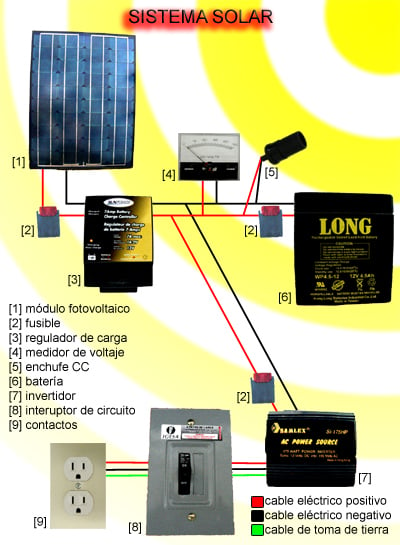Photovoltaics Learning Station:
The students and faculty at la Universidad Technológia de Coahuila (UTC) are interested in learning more about photovoltaics. Located in Parras, Coahuila, this technology-oriented university has a three-year relationship with professor Lonny Grafman and Humboldt State University’s appropriate technology program. Lonny provided a PV module, charge controller, battery, and inverter; these components and the desire to learn about PV provided the perfect opportunity to construct a small photovoltaic learning station. The goal of the project was to create a functional, convenient, portable, and instructional learning station and to ensure the involvement and sustained interest of UTC faculty. This station will be used by UTC students, the community and schools of Parras, and by future Humboldt State Parras Program students as a hands-on demonstration of photovoltaics. We aim to make the station attractive and informative to teachers, students, and potential consumers of this viable alternative energy. A concise list of our criteria for success includes:
- functional
- convenient
- instructional
- safe
- attractive/"nifty"
- portable
- easy to use and maintain
- durable
- adaptable to change if necessary
Method, Materials, Budget:
Many of the parts that make up the project were donated, which limited the scope of our project but at the same time, made things a little easier. The donated items were a Sunforce 7A/14.2V battery charge controller, a Long 12V/4.5Ah Deep Cycle Battery, a Samlex SI-175HP 175watt AC inverter that converts 12 DC volts to 115 AC volts, a GE PV-050MNA solar panel with a 50watt/17.3V/2.9A capacity, and a 15A fuse. Considering what we had, to complete the system, we needed to find: a circuit breaker and box with a 10A capacity, more 10A-15Afuses, 12 guage wire, Remex wire, a DC plug, a wall outlet, conduit, waterproof paint, nuts & bolts, mounts for the various components, and wood to mount everything on. We figured the 10A circuit breaker was necessary over other amperages because we wanted it to switch off if too much current was flowing through the system. Finding anything in between 10A-20A was difficult, so we went with what we could find. The 10A fuse was the only one we could find from an auto parts store in town, so we decided to go with that. 12 guage wire was used because of the small size of the system. Remex was great so that we could actually ground the system, reducing the threat of someone getting shocked. We had one DC plug that went from the charge controller/battery parallel to the AC inverter. We needed another because the UTC staff decided that they would like to hook up the system to run a small refrigerator. Since refrigerators run off of DC current, we decided to splice it in to parallel with the PV charge controller/battery so that they had that option. The wall outlet was for any AC device that was going to be run off the system. We drew up a design for the learning station and decided that it would be best to leave the solar panel separate so that people had the opportunity to move with as much ease as possible.
The Curriculum

En Español
SISTEMA SOLAR
[1] Módulo Fotovoltaico (Panel Solar) Convierte la energía solar en energía eléctrica.
[2] Fusible Corta el circuito si el amperaje (corriente) se vuelve muy alto. Demasiada corriente puede quemar un sistema completo, en vez de esto, el fusible se quema primero. Una vez que el fusible está quemado, necesita ser remplazado.
[3] Regulador de Carga Le regula el voltaje a la batería, previniendo que ésta se sobrecargue.
[4] Medidor de Voltaje Te indica el voltaje del sistema o la corriente y energía que pasa de los paneles a las baterías.
[5] Enchufe CC Te permite enchufar aparatos electrodomésticos 12VCD directamente al sistema.
[6] Batería de Gran Ciclo Almacena energía para los momentos con insuficiente luz del sol.
[7] Invertidor Convierte la energía CD, generada por el panel, en energía CA para consumo.
[8] Interuptor de Circuito Actúa como un gran fusible automático que interrumpe el circuito cuando la corriente llega a ser muy elevada. Se puede cambiar de regreso cuando el sistema este listo para operar de nuevo.
[9] Contactos Permite que un aparato electrodoméstico CA se enchufe a la energía generada por el sistema. La electricidad será extraída, ya sea del panel directamente, o de la energía almacenada en la batería o alguna combinación dependiendo del estado del sistema o las necesidades de carga.
In English
SOLAR SYSTEM
[1] Solar Panel Converts solar energy into electrical energy.
[2] Fuse Cuts the current when the amperage gets too high. It prevents the system from frying, but once it has fried, it needs to be replaced.
[3] Charge Controller Regulates the voltage going in to the battery and prevents it from overcharging.
[4] Voltage Meter Shows the voltage passing through the wires from the panels to the batteries.
[5] DC Plug Allows you to plug in 12 volt DC appliances directly to the system.
[6] Deep Cycle Battery Stores the energy for times when there is not much sun.
[7] Inverter Converts the DC energy produced by the panel to AC energy.
[8] Circuit Breaker Acts as a big fuse when the current gets too high for the system to handle. You can switch it back on when the system is ready again.
[9] Outlet Allows you to connect AC appliances directly to the system. The energy can come from the panel directly, the battery, or a combination of the two.